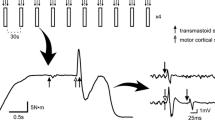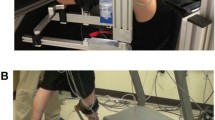Summary
We investigated the hypotheses (1) that the initial flexion part of the wipe reflex elicited in the spinalized frog has the same EMG pattern for wipes to different target locations (Berkinblit et al. 1986), thereby reducing the complexity of the control of this task, and (2) that this initial flexion is the same as occurs in the flexion withdrawal reflex (Easton 1972). The activities of seven muscles of the hindlimb of the spinal frog were recorded via intramuscular electromyograms (EMGs) during the wipe reflex to two target locations and during the flexion withdrawal reflex. The EMGs were analyzed during the interval between stimulus placement and movement onset for mean integrated EMG and duration from EMG onset to movement onset. This analysis revealed significant differences (p<0.0001) in the EMG patterns that preceded the initial flexion posture for all three movements. These findings suggest that the spinal circuitry coordinating the initial flexion part of the wipe reflex to different target locations and the flexion withdrawal reflex may not be uniformly shared.
Similar content being viewed by others
References
Berkinblit MB, Feldman AG, Fukson OJ (1986) Adaptability of innate motor patterns and motor control mechanisms. Behav Brain Sci 9:585–638
Berkinblit MB, Zharkova IS, Feldman AG, Fukson OI (1984) Biomechanical aspects of the wiping reflex cycle. Biophysics 29:530–536
Bernstein N (1967) The coordination and regulation of movements. Pergamon Press, New York
Currie SN, Stein PGS (1989) Interruptions of fictive scratch motor rhythms by activation of cutaneous flexion reflex afferents in the turtle. J Neurosci 9:488–496
Easton TA (1972) On the normal use of reflexes. Am Scientist 60:591–599
Franzisket L (1963) Characteristics of instinctive behavior and learning in reflex activity of the frog. Anim Behav 11:318–324
Fukson OI, Berkinblit MB, Feldman AG (1980) The spinal frog takes into account the scheme of its body during the wiping reflex. Science 209:1261–1263
Lee WA (1984) Neuromotor synergies as a basis for coordinated intentional action. J Motor Behav 16:135–170
Robertson GA, Stein PSG (1988) Synaptic control of hindlimb motoneurones during three forms of the fictive scratch reflex in the turtle. J Physiol 404:101–128
Sherrington CS, Laslett EE (1903) Observations on some spinal reflexes and the interconnections of spinal segments. J Physiol 29:58–96
Stein PSG (1983) The vertebrate scratch reflex. In: Roberts A, Roberts B (eds) Neural origins of rhythmic movements. Society for Experimental Biology Symposium XXXVII
Author information
Authors and Affiliations
Rights and permissions
About this article
Cite this article
Schotland, J.L., Lee, W.A. & Rymer, W.Z. Wipe and flexion withdrawal reflexes display different EMG patterns prior to movement onset in the spinalized frog. Exp Brain Res 78, 649–653 (1989). https://doi.org/10.1007/BF00230254
Received:
Accepted:
Issue Date:
DOI: https://doi.org/10.1007/BF00230254




